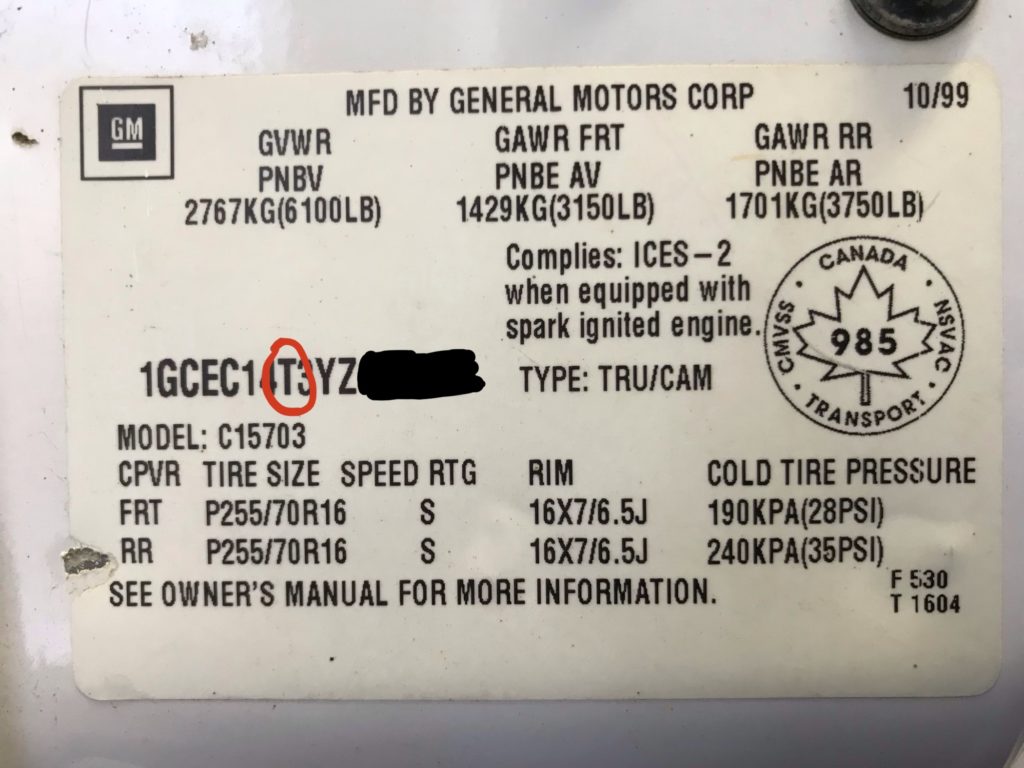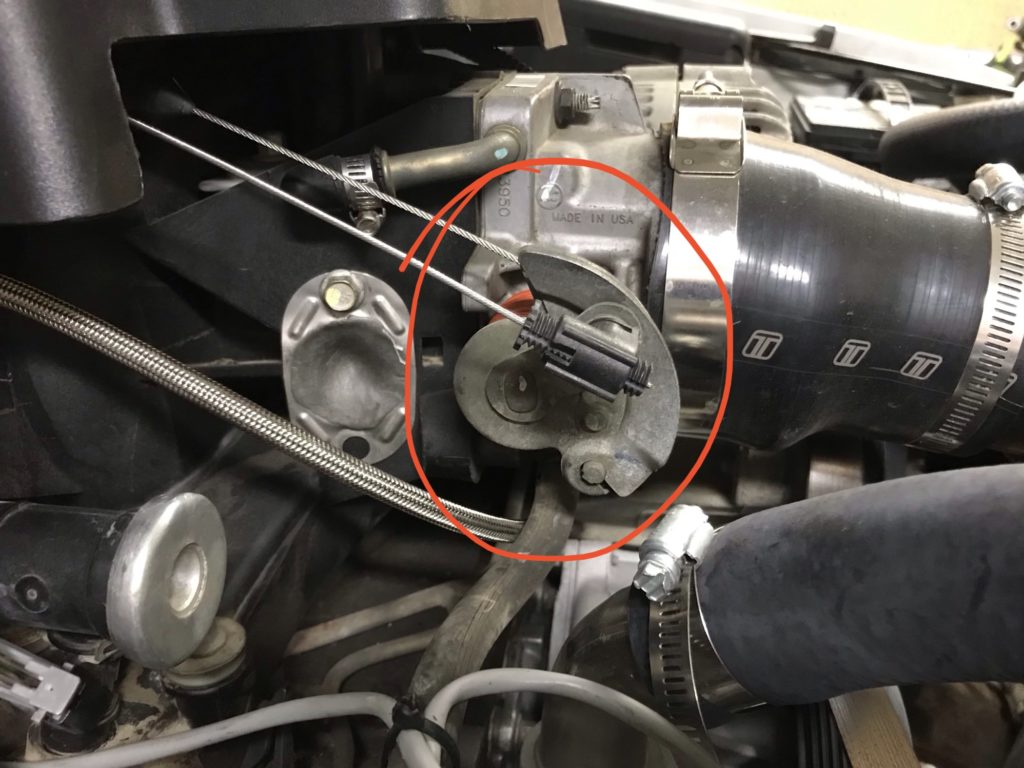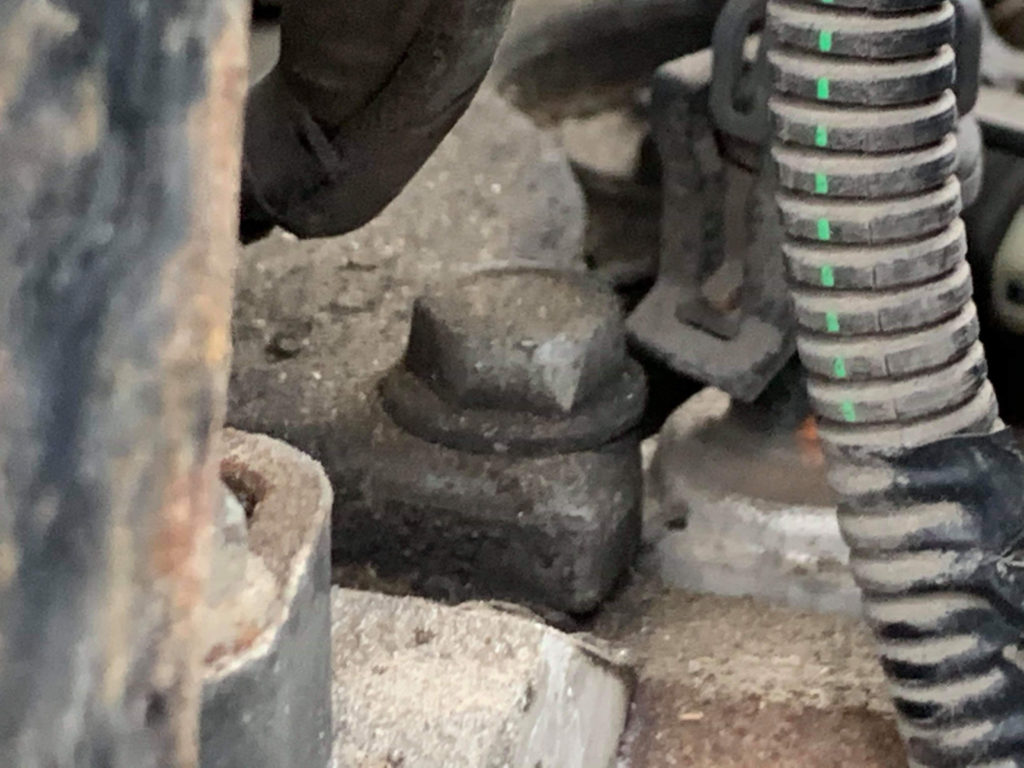Hi guys,
In this week’s article, I’m going to show you how to tell the difference between a Gen 3 and a Gen 4 LS engine. As usual, I’m going to be focusing mainly on the 4.8, 5.3 and 6.0L LS-based Vortec truck engines since they are the most common ones you’ll find when you’re hunting through a junkyard. If you do find a car LS engine, it’s probably going to be expensive.
I’ll be doing a more detailed article next week about the evolution of the Vortec truck engines but figured it would be worth doing a quick one on how to tell a Gen 3 from a Gen 4. The next one will cover more information about specific models.
If the engine is still in the vehicle, the easiest way to identify the engine is using the 8th digit of the VIN. Here’s a photo of the VIN sticker found on the driver’s door of my 2000 Chevy Silverado 1500.

The 8th digit of the VIN is “T.” (Circled in red in the attached photo.) From the table below, we can tell that this is a Gen 3, 5.3L, LM7 engine.

Here’s a similar table for Gen 4 truck engines.

If you don’t have the VIN, if, for example, you find an engine sitting on a pallet at the junkyard, here some ways you can visually tell a Gen 3 from a Gen 4 engine.
First of all, if it has a throttle cable attached to the throttle body, like my truck does in the attached picture, it is a Gen 3. However, the opposite isn’t necessarily true. Just because an engine has a drive-by-wire throttle body (no throttle cable), it doesn’t mean that it’s a Gen 4. Some Gen 3’s had drive-by-wire, but no Gen 4’s were drive-by-cable.

Another way to tell is by looking at the timing cover on the front of the engine. This information comes from Summit Racing, and they have a handy tool for identifying these engines, here’s a link to their tool. The following images were taken from this link.
If the timing cover is plain with no black pickups on the front of it, the engine is a Gen 3. See attached photo. If it has at least one pickup on the timing cover, it’s a Gen 4 engine.

Next, you can look at the intake manifold. If the manifold is low, smooth, and rounded, it is a car engine, so if it’s a Gen 3, it will be an LS1 or LS6 engine. If the manifold is taller and boxier, has ribs on the top, or still has the “Vortec” plastic cover on it, it’s a truck engine. See the photo below.

The next thing to check is whether the block is iron or aluminum. An easy way to check this is with a magnet. A magnet will stick to an iron block but won’t stick to an aluminum block. You should also note the displacement markings cast onto the block. These will be found on the front of the engine, underneath the driver’s side cylinder head, to the right of the water pump, as shown in the attached pictures.

If it’s a Gen 3 engine, with an iron block, and a truck intake manifold, with a 4.8/5.3 stamped on the block, it’s either a 4.8L LR4 engine or a 5.3L LM7 or L59 engine. There’s no easy way to tell visually from the outside of the engine whether it’s a 4.8 or 5.3L. If you have a borescope or pull a cylinder head, the 4.8 usually has flat-topped pistons and the 5.3 usually has dished pistons but there’s no way to see that from the outside.
If it’s a Gen 3 with an iron block and a truck intake manifold and has 6.0 stamped on the block, it’s an LQ4 or LQ9 6.0L engine.
If it’s a Gen 3 aluminum block engine with a truck manifold, it’s a 5.3L LM4 or L33 engine.
Another identifying feature that was pointed out by Kent Dalton for the 6.0L is that the Gen 4 6.0L engines have 13mm valley cover bolts while the Gen 3 has 10mm valley cover bolts. See attached photo.

If it’s a Gen 4, there are a lot more options as to what model it could be, some of them have AFM/DOD, some have variable valve timing, etc but we’ll cover that more in the next article, but for now, this one should help you be able to identify whether you’re looking at a Gen 3 or a Gen 4 LS truck engine.
Next time, we’ll go into more detail about the evolution of the LS-based Vortec truck engines. We’ll cover the following topics:
- which ones came with drive by cable throttle bodies
- which ones came with drive by wire throttle bodies
- which ones had 24x reluctor wheels
- which ones had 58x reluctor wheels
- which ones had flex-fuel
- which ones had active fuel management/displacement on demand
- which ones have variable valve timing
- the difference between AFM/DOD and VVT
- which ones used return style fuel systems and which ones were returnless
- which ones had iron blocks
- which ones had aluminum blocks
- which cylinder heads came on each engine
- which cylinder heads are most desirable, and which ones to stay away from
- help you choose a suitable donor for your LS swap or LS turbo project, and which ones to avoid.
That’s all for this week, see you next time.
Randy (Lowbuck LS)


Sweet thanks for info…looking forward to changing my intake on my 2004 model Silverado 5.3 which actually has the 2003 head bolt setup:/…kind of wondering why I took that bolts are different and if I can either change my 706 heads and then can I use the newer style head bolts then?..or do I have to get a different newer block?..also my fuel system is returnless with no vacuum lines or regulator so can my tbss intake with no return line fuel lines work just fine without all the vet fuel pump setups for returns..I’m guessing that’s the point of one line ??lol. Thanks ..Chris disabledveteran
Thx u thx u please keep on writing on how to’s really appreciate it
I just watched a YouTube video where a shop tried 706 heads vs 317 and I guess the 317 flow more but the smaller combustion chamber on the 706 beat it out every time on the dyno they used a comp cam and springs and got nice numbers then boost and it just went off the charts
The YouTube video with all the great dyno and cam and turbo info i mean he tells you what cam, head and turbo makes what power so if you want those numbers you only have to write down what he tells you buy that stuff and boom you know what your power is https://youtu.be/gJCT5RvPCwM
Very good information.
Hi I’m Daniel I’m waiting on a delivery on a 6.2 L L92.
They say is a 8 th digit is 8 on the Vin.
How do I check to make sure.
I got a Gen 3 LR4 (V) 4.8 Iron Block Alum 862 heads it has flat top pistons in it I purchased a Engels stage three sloppy cam kit came with springs bearings it has a 4L 60 E transmission in it. I was wanting to know am I gonna need a great push rods and what’s your recommendation on the torque converter ? It’s in a 2000 Chevy Silverado 1500 Extended cab short bed rear wheel drive thanks